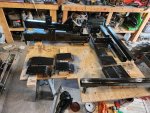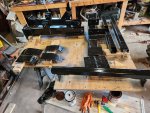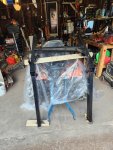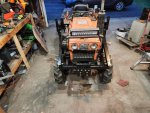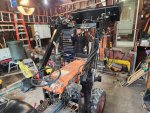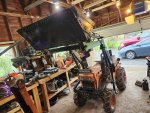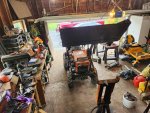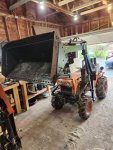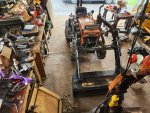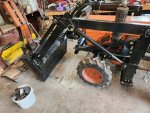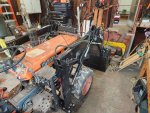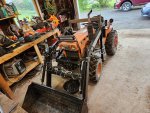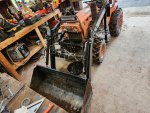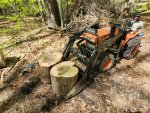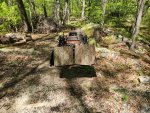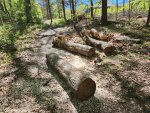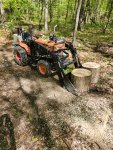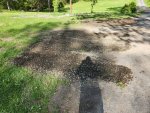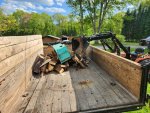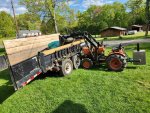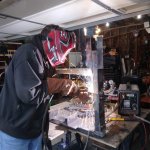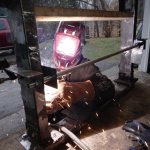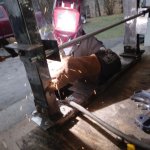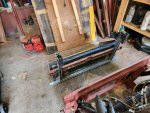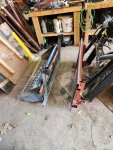trial and error
Well-known member
Equipment
B7100dt manual trans. homemade FEL, 4 way hydraulic dozer blade
Side note I already private messaged Vigo all of this. I am just publically posting it here for others who share the valid concerns
To start I appreciate the comcern concern with the less then steller and even less so strong looking "welds" I won't even call them welds becuase it is an insult to a proper welder with good equipment and experience. My biggest issue with consistency has and continues to be the welder striking a consistent arc. Sometimes it does great and most of time it's complains the whole time and I get the visual results I've been posting. I throughly clean all my mating surfaces within several inches of the "weld area" and have my ground also on clean bare metal every time so those two variables are not it. Anyway this isn't the point of this post . I again appreciate the concern and do not want to become known as the guy who either thinks he knows it all, or the guy who throws all caution to the wind. We can all stand to learn something. I do understand static load testing versus shock load testing and have already done some of both, both intentionally and unintentionally. I don't have a 3lb sledge or a proper cold chisel, so I'm improvising and will use my 8lb sledge and a splitting wedge I dont care about . I have beaten on all of my "welds" with my largest ballpoen hammer and also several with the 8 lb sledge.I have used a 3+ foot pry pay to pry on several of the bracket "welds" to the point of bending the pry bars spring steel. I have also had a 4 foot peice of 2x4 in between one of the sets of brackets trying to open the space just a hair due to some warping from "welding". The brackets haven't budged from any of this. My wife also unintentionally lifted the entire font of the tractor off the ground 6 inches with the electric hoist attached to my loader arms and garage trusses, while "helping" me. Now I understand most of this is just dynamic testing not shock loading. So I have also unintentionally dropped the entire assembly over 5 feet twice, once when my ratchet strap "sling" broke and it caught 6 inches off the ground by the strap I had on the" bucket" thus "shock loading" a lot of the bracketry as well as my garage hoist. The other time it fell was when I didn't have the chain hooked into the hoist properly but pretty much the same thing happened. I will also now try the chisel method but I don't expect any catastrophic failure and if t happens like has been pointed out, better on the bench test then in a work test. I also know my "welds" look "cold" but I can assure you they are not. On the ones I have ground I have found good fusion. And the heat markings on the surrounding metal supports that, as well as the 3 left handed welding gloves which are cooked in the area around my index finger and thumb.
Besides the chisel test I'm not sure what other shock testing I can do but I'm open to suggestions, before I go do "real life" tests. I also have no intention of lifting anything delicate anytime until I'm confident in this thing both in form and function so no concern there. My 3pgm pump should keep things nice and slow but their is shock loading that wil come from driving over bumps/uneven ground.
Thanks again all for the valid concerns, and reality checks of what can happen. I am doing my best to test things before I put myself or the machine
in danger from a catastrophic failure in the feild
To start I appreciate the comcern concern with the less then steller and even less so strong looking "welds" I won't even call them welds becuase it is an insult to a proper welder with good equipment and experience. My biggest issue with consistency has and continues to be the welder striking a consistent arc. Sometimes it does great and most of time it's complains the whole time and I get the visual results I've been posting. I throughly clean all my mating surfaces within several inches of the "weld area" and have my ground also on clean bare metal every time so those two variables are not it. Anyway this isn't the point of this post . I again appreciate the concern and do not want to become known as the guy who either thinks he knows it all, or the guy who throws all caution to the wind. We can all stand to learn something. I do understand static load testing versus shock load testing and have already done some of both, both intentionally and unintentionally. I don't have a 3lb sledge or a proper cold chisel, so I'm improvising and will use my 8lb sledge and a splitting wedge I dont care about . I have beaten on all of my "welds" with my largest ballpoen hammer and also several with the 8 lb sledge.I have used a 3+ foot pry pay to pry on several of the bracket "welds" to the point of bending the pry bars spring steel. I have also had a 4 foot peice of 2x4 in between one of the sets of brackets trying to open the space just a hair due to some warping from "welding". The brackets haven't budged from any of this. My wife also unintentionally lifted the entire font of the tractor off the ground 6 inches with the electric hoist attached to my loader arms and garage trusses, while "helping" me. Now I understand most of this is just dynamic testing not shock loading. So I have also unintentionally dropped the entire assembly over 5 feet twice, once when my ratchet strap "sling" broke and it caught 6 inches off the ground by the strap I had on the" bucket" thus "shock loading" a lot of the bracketry as well as my garage hoist. The other time it fell was when I didn't have the chain hooked into the hoist properly but pretty much the same thing happened. I will also now try the chisel method but I don't expect any catastrophic failure and if t happens like has been pointed out, better on the bench test then in a work test. I also know my "welds" look "cold" but I can assure you they are not. On the ones I have ground I have found good fusion. And the heat markings on the surrounding metal supports that, as well as the 3 left handed welding gloves which are cooked in the area around my index finger and thumb.
Besides the chisel test I'm not sure what other shock testing I can do but I'm open to suggestions, before I go do "real life" tests. I also have no intention of lifting anything delicate anytime until I'm confident in this thing both in form and function so no concern there. My 3pgm pump should keep things nice and slow but their is shock loading that wil come from driving over bumps/uneven ground.
Thanks again all for the valid concerns, and reality checks of what can happen. I am doing my best to test things before I put myself or the machine
in danger from a catastrophic failure in the feild


